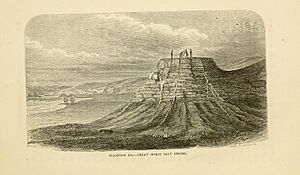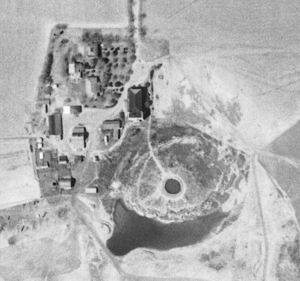Waconda Spring facts for kids
Waconda Spring, also known as Great Spirit Spring, was a special natural spring in Mitchell County, Kansas, USA. It was located near the towns of Glen Elder and Cawker City. For many Native American tribes of the Great Plains, it was a sacred place. Later, American settlers used it as a health spa. However, in 1968, the Glen Elder Dam was finished. This caused the mineral spring to disappear under the new Waconda Reservoir.
Contents
What Was Waconda Spring Like?
Waconda Spring sat on the bank of the Solomon River. The water from the spring had built up a large cone-shaped mound around it. This mound was made of a rock called travertine.
In 1866, a surveyor named David E. Ballard described it. He said the spring was a "curiosity." It was on top of a cone-shaped limestone rock. This rock was about 200 feet wide at the bottom and 30 feet tall. The spring's basin on top was round, about 30 feet wide, and 20 feet deep. The water was very salty.
Native American Stories and Beliefs
The name "Waconda" comes from the Kanza language. It means "spirit water" or "Great Spirit Spring." The spring was in land controlled by the Pawnee tribe. They called it "Pahowa" or "Kitzawitzuk," which means "water on a bank."
In the Pawnee religion, there is a supreme being named Tirawa. Tirawa gives special powers to certain animals. These animals, called nahurac, were like Tirawa's helpers and messengers. They would speak to Tirawa for the Pawnee people.
The nahurac had five special places, and Waconda Spring was one of them. These places were considered very important. Other Native American tribes also respected Waconda Spring. They often threw valuable items into the spring as offerings. These offerings included blankets, beads, eagle feathers, and moccasins.
About two miles southwest of the spring, there was a large geoglyph. This is a design made on the ground by removing the top layer of grass. It showed an animal, possibly a beaver. Experts believe it is hundreds of years old. It seems the figure was remade at least once, showing it was used for a long time.
A Look Back at Waconda Spring's History
The first recorded visit by a European to Waconda Spring was by General Zebulon Pike in 1806. He visited during his exploration of the Great Plains.
People started settling in the area after Kansas became a state in 1861. In 1870, a man named Pfeiffer made the first claim on the land. Kansas Senator Samuel C. Pomeroy visited in 1870. He was amazed by the spring. He thought it looked like an ancient volcano crater. He said the water was very deep and always overflowing. Pomeroy believed the site had great potential. He predicted a health resort would soon be built there.
Just a few years later, a man named Burnham built a factory to bottle the spring water. He sold it as a health tonic called Waconda Flier. An investor named McWilliams became interested. In 1884, he invested in the site. He began building a large stone sanitarium, which is like a health resort. The spring was fenced off and became private property.
The building was finished ten years later. Under the management of G. W. Cooper, Waconda Spring became a popular hotel and health spa. Waconda Flier continued to sell well. By the 1890s, it was sold all over the country. In 1904, Waconda Flier even won a medal for its health benefits at the St. Louis World's Fair.
The Abrahams-Bingesser family owned and ran the spa for many years. They improved the resort and kept its good reputation. The spa offered different therapies, like physical therapy and water therapy. Water from Waconda Spring was used for many treatments. A popular slogan for the resort was, "It will clean works until your works work." Waconda Spring was a successful business for the family until 1964.
The Glen Elder Dam and the Spring's Disappearance
In 1944, government agencies announced plans for a large dam on the Solomon River. This dam would flood the area where Waconda Spring was located. The Bingesser family tried to stop the plan.
However, in 1951, Kansas had massive floods. This led to strong demands for new dams and flood control projects. The Glen Elder Dam project was pushed forward again. A water expert studied Waconda Spring. He concluded that the spring was unique and possibly the only one of its kind in the world. But those who wanted the dam built dismissed his findings. They called Waconda Spring "nothing more than a mud hole."
Construction on the Glen Elder Dam began in 1964. It was finished by the end of 1968. Engineers bulldozed the hotel and health spa. They then dumped the debris into the spring's pool. Water from the Solomon River began to fill the valley. By 1970, the valley was completely full, and Waconda Spring was gone forever beneath the reservoir.



